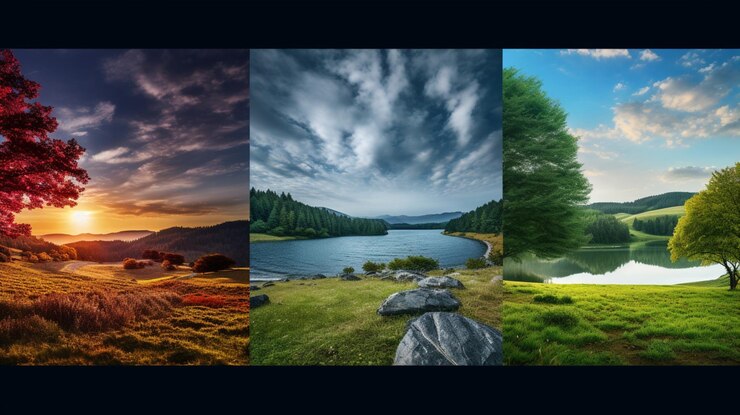HDR photography, or High Dynamic Range photography, is a powerful technique that can transform your images, especially when dealing with challenging lighting conditions. In this comprehensive guide, we’ll delve into the world of HDR photo editing, exploring its benefits, the editing process, and tips for success.
Understanding HDR Photography
Dynamic range refers to the range of brightness levels in a scene, from the darkest shadows to the brightest highlights. In photography, a wider dynamic range allows for capturing more detail in both shadows and highlights, resulting in a more balanced image. Traditional photography often struggles to capture scenes with high contrast, leading to loss of detail in either shadows or highlights. HDR photography addresses this limitation by combining multiple exposures to capture the full range of light in a scene.
HDR photo editing involves capturing multiple exposures of the same scene at different exposure levels, from underexposed to overexposed, in order to enhance the dynamic range of the image. These exposures are then merged using specialized software to create a single image with enhanced dynamic range. Several software options are available for HDR editing, including Adobe Photoshop, Lightroom, and Photomatix. These tools offer various features for merging exposures, adjusting tonal range, and fine-tuning details.
Benefits of HDR Photo Editing
HDR editing, or High Dynamic Range editing, offers a powerful solution for enhancing your photos, especially those taken in challenging lighting conditions. By combining multiple exposures of the same scene, HDR editing brings out details in both the highlights and shadows, resulting in images with greater depth and clarity.
- Overcoming Exposure Challenges: HDR editing allows photographers to salvage photos with extreme highlights and shadows, revealing details that would otherwise be lost in a single exposure.
- Enhancing Details and Textures: One of the key benefits of HDR editing is its ability to reveal intricate details and textures in both highlights and shadows, resulting in more visually compelling images.
- Achieving Natural-Looking Results: Contrary to misconceptions, HDR editing can produce natural-looking results when used judiciously. By carefully adjusting tonal range and contrast, photographers can create images that maintain a sense of realism.
- Creative Possibilities: HDR editing opens up a world of creative possibilities, allowing photographers to create surreal landscapes, dramatic architectural shots, and other artistic effects.
Step-by-Step HDR Photo Editing Process
Enhancing the luminance and detail of your photos through HDR (High Dynamic Range) editing can seem daunting at first, but fear not! With a step-by-step approach, you can unlock the full potential of your images, especially those taken in low-light or high-contrast conditions. In this guide, we’ll break down the HDR editing process into manageable steps, making it accessible for beginners and experienced photographers alike.
Preparing Your Photos
To prepare for HDR photo editing, capture bracketed exposures by adjusting the exposure compensation or using auto-bracketing mode on your camera. Organize your files for easy access during the editing process.
- Adjust exposure compensation or use auto-bracketing mode for bracketed exposures.
- Organize files for easy access during editing.
- Ensure proper lighting conditions for capturing bracketed exposures.
- Check camera settings to ensure consistent exposure across bracketed shots.
- Use a tripod to minimize camera shake and ensure alignment between exposures.
Merging Exposures
Using HDR software such as Adobe Photoshop or Photomatix, merge your bracketed exposures into a single HDR image. Follow the software’s instructions for optimal results.
- Open HDR software and import bracketed exposures.
- Follow software instructions for merging exposures into a single HDR image.
- Adjust alignment and ghost reduction settings if necessary.
- Preview merged HDR image to ensure desired result.
- Save merged HDR image as a new file to preserve original exposures.
Tone Mapping
Tone mapping is a crucial step in HDR photo editing, where you adjust the tonal range of the HDR image to achieve the desired look. Experiment with different settings to find the right balance of contrast and saturation.
- Experiment with tone mapping presets to enhance image tonality.
- Adjust sliders for exposure, contrast, and saturation to fine-tune tone mapping.
- Use local adjustments to target specific areas of the image.
- Compare different tone mapping algorithms to find the most suitable one.
- Preview changes in real-time to gauge their impact on the image.
Fine-Tuning Adjustments
After tone mapping, fine-tune your image by adjusting exposure, contrast, color balance, and sharpening. Pay attention to detail to ensure a polished final result.
- Use adjustment layers for non-destructive editing.
- Refine exposure adjustments to balance highlights and shadows.
- Adjust contrast to enhance image depth and dimension.
- Fine-tune color balance to achieve natural-looking tones.
- Apply sharpening to enhance image detail without introducing artifacts.
Saving and Exporting
Once you’re satisfied with your edits, save your HDR image in a suitable format for web or print use. Consider exporting multiple versions for different purposes, such as social media sharing or printing.
- Choose appropriate file format (e.g., JPEG, TIFF) for saving HDR image.
- Optimize file size and compression settings for web or print use.
- Consider creating multiple versions with varying resolutions for different platforms.
- Add metadata and copyright information to protect your work.
- Create backups of edited HDR images to prevent loss of data.
Tips and Tricks for Successful HDR Photo Editing
HDR photo editing can be a game-changer for your photos, especially when dealing with challenging lighting situations. By blending multiple exposures, HDR (High Dynamic Range) editing allows you to capture a wider range of light and detail, from the brightest highlights to the deepest shadows.
Shooting Tips
When capturing bracketed exposures, pay attention to composition and lighting conditions to ensure consistent results across exposures.
Choosing the Right Software
Experiment with different HDR editing software options to find the one that best suits your workflow and editing style. Consider factors such as user interface, features, and compatibility with your existing software ecosystem.
Avoiding Common Pitfalls
Common mistakes in HDR editing include over-saturation, halo artifacts, and unrealistic tonal mapping. Take time to refine your editing techniques and learn from your mistakes.
Experimenting with Styles
Don’t be afraid to experiment with different HDR styles and techniques to develop your unique editing style. Embrace creativity and push the boundaries of traditional photography.
Professional Photo Editing Services
For photographers who prefer to outsource their editing, professional editing services offer convenience and expertise. These services can handle HDR photo editing, retouching, and other post-processing tasks. When choosing a professional editing service, consider factors such as turnaround time, pricing, and quality of edits. Research different providers and read reviews to make an informed decision.
Tips for Working with Professional Editors
Communicate your preferences and expectations clearly when working with professional editors. Provide reference images and detailed instructions to ensure the desired outcome.
- Clearly communicate your goals and expectations for the editing process.
- Provide detailed guidelines or a style guide to ensure consistency in editing.
- Be open to feedback and constructive criticism from the editor.
- Respect the editor’s expertise and trust their judgment.
- Establish clear timelines and deadlines for editing tasks.
- Communicate any changes or updates to the project promptly.
- Be prepared to discuss revisions and changes with the editor.
- Maintain professional and respectful communication throughout the process.
- Consider establishing a contract or agreement outlining terms and responsibilities.
- Express gratitude for the editor’s work and dedication to improving your project.
In conclusion, HDR photo editing is a valuable tool for photographers seeking to enhance their images and overcome exposure challenges. By understanding the HDR process, mastering editing techniques, and exploring professional editing services, you can elevate your photography to new heights. Don’t hesitate to embrace HDR editing and unlock the full potential of your photos.



